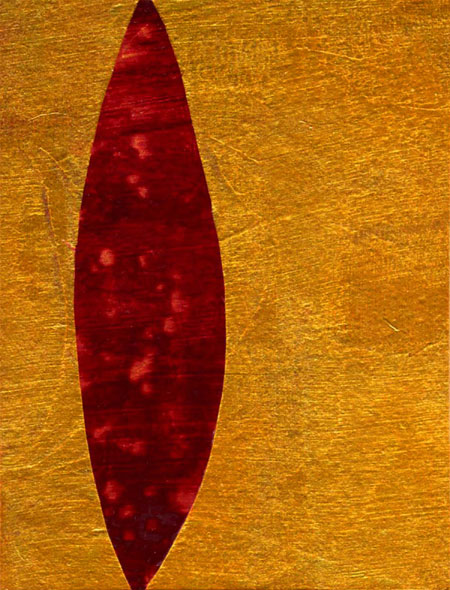 Image: Into the Wound © Jan Richardson
Image: Into the Wound © Jan Richardson
Reading from the Gospels, Easter 2: John 20.19-31
Tonight I pulled out a card, received from a friend years ago. On the front of the card is Caravaggio’s depiction of the scene that we find in this week’s lectionary reading. As Caravaggio sees it, Christ stands to the left, chest bared, drawing Thomas’s hand into his wound as two other disciples look on. It is an intimate scene: Christ bows his head over Thomas’s hand, gazing at Thomas as he pulls him toward his wound; Thomas leans in, brow furrowed, the other disciples standing so close behind him they threaten to topple him straight into Jesus. Yet Thomas seems about to tumble into the wound of his own accord. He is doing more than merely looking where Christ leads him; his whole being is absorbed in wonder. The first time I saw this image, I immediately had the sense that Thomas was thinking, There’s another world in there.
The title sometimes given this remarkable painting, and this remarkable man, is “Doubting Thomas,” which grates a bit. Three weeks ago, contemplating the gospel lection for Lent 5, I was reminded that in the story of the raising of Lazarus, Thomas is the one—the only one—who steps forward and expresses his willingness to die with Jesus. In this week’s reading, Thomas once again crosses into a place where others have not ventured: into the very flesh of the risen Christ.
Caravaggio’s painting illumines a point that the gospel writers are keen to make in the post-resurrection stories of Jesus. They want to make sure we know that the risen Christ was no ghost, no ethereal spirit. He was flesh and blood. He ate. He still, as Thomas discovered, wore the wounds of crucifixion. That Christ’s flesh remained broken, even in his resurrection, serves as a powerful reminder that his intimate familiarity and solidarity with our human condition did not end with his death. Perhaps that’s what strikes me so about Caravaggio’s painting: it stuns the viewer with the awareness of how deeply Christ was, and is, joined with us. The wounds of the risen Christ are not a prison; they are a passage. Thomas’s hand in Christ’s side is not some bizarre, morbid probe: it is a union, and a reminder that in taking flesh, Christ wed himself to us.
The presence of the Christ who joins himself to us, who is intimately acquainted not only with the delights that come in being human but also in the ways it breaks us open, comes as a particular solace this week. As I write this in the middle of the night, my sweetheart is keeping vigil by his mother’s hospital bed. She is dying. Just a month ago, we—Gary and his brothers and their families—threw a surprise party to celebrate Shirley’s 80th birthday. Shortly afterward, she was diagnosed with a recurrence of leukemia, and where we expected that another series of chemo would buy her some more time, complications set in with startling speed in the past week. Shirley remained alert until Gary and his three brothers arrived to be with her, and now she is letting go.
In a dozen hours I’ll fly to North Carolina, where Shirley’s extended family has begun to gather. I’ve been doing laundry today, working on taxes, paying bills, doing dishes, preparing for a retreat I’m scheduled to lead in Connecticut next weekend—all the mundane and sometimes marvelous details of life that persist even as another life is ending. As I pack, I’ll tuck in the card that my friend gave me all those years ago. And instead of Doubting Thomas, perhaps I’ll call him Believing Thomas. Thomas Who Asked for What He Needed. Thomas Who Crossed the Boundary.
Perhaps I’ll call him Thomas of the Passage, who reached out his hand and found what Shirley is finding in these passing hours:
There’s another world in there.
[To use the image “Into the Wound,” please visit this page at janrichardsonimages.com. Your use of janrichardsonimages.com helps make the ministry of The Advent Door possible. Thank you!]













March 30, 2008 at 2:58 PM |
This is such a beautiful interpretation, especially your phrase not a prison but a passage. I will think of your family over the next few days and hope Shirley finds the passing easy.
March 31, 2008 at 9:48 AM |
What a beautiful way of seeing Thomas. I would probably have wanted to see the wounds myself so I can’t fault the guy for that, especially since it is so clear that Christ does not look like himself in this new physical form.
April 3, 2008 at 11:16 AM |
Breathtaking insight! Thank you Jan. You and your family are in my prayers.
April 13, 2009 at 2:47 PM |
Revisiting this post as I reflect on this passage a year later, I want to offer belated thanks for your comments, Tess and Jules and Beth. I’m grateful for your words and for the thoughts and prayers you offered during that time. Thank you!
May 6, 2011 at 7:31 PM |
Thank you
April 12, 2018 at 6:08 AM |
Thank you, ten years later, for this.